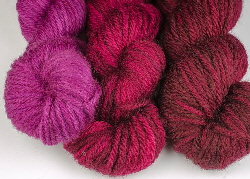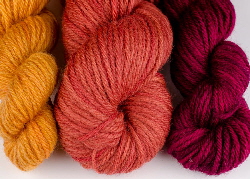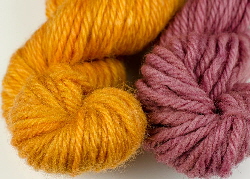|
|
Fig 1. Different colours with varying amounts of brazilwood (using ¾ teaspoon of chalk):
|
|

|
|
[L-R] 5%; 20%; 50% sappanwood (to weight of fibre = wt.%)
|
|
|
Fig 2. Varying colours with different amounts of chalk (using 20% sappanwood):
|
|

|
|
[L-R] no chalk; pinch of chalk; ¾ teaspoon of chalk
|
|
|
Fig 3. Colours with no chalk & chalk added afterwards:-
|
|

|
|
[L-R] no chalk; chalk added after
|
|
This dye is beautiful on newly dyed textiles, producing bright and beautiful red colours. Brazilwood has several advantages that make it a good choice as a first natural dye. It is easy to use, relatively inexpensive, and a little goes a long way. It is great for re-enactors because sappanwood is an authentic red dye from the medieval period. Brazilwood is wash-fast, but if it is exposed to too much light it will fade to a reddish brown. It is, therefore, more suitable for occasional or evening wear rather than for curtains.
a) Dyeing with brazilwood powder (this page)
b) Dyeing with brazilwood extract (opens a new page)
c) Back to brazilwood biology & history (new page)
Dyeing with brazilwood powder
Important: Chalk (calcium carbonate) can make a very big difference to the colour of the dyed item. If you don’t use chalk when dyeing wool with brazilwood, you may get oranges. If you add a pinch of chalk the colour turns to reds; adding more chalk (1/3 to ¾ of a teaspoon) turns the wool toward crimson and lavender (see Fig 2). Add the chalk to the dye bath after you have strained the brazilwood and before adding the wool.
If you do not do that and your wool comes out orange, you can simmer the wool with a little chalk later on (see Fig 3), but this is not as successful as adding the chalk to the original brazilwood bath.
Brazilwood is sensitive to the pH of the water; acids (vinegar or citric acid) will make the colour more orange and alkalis (soda ash) will give you blue reds and purples. Brazilwood is also sensitive to iron; a pinch of iron will turn brazilwood towards lavender.
You will need:
- brazilwood powder
50 grams for fiery red, clarets and deep crimson OR
20 grams for warm reds OR
5 to 7 grams for pinks and corals (see Fig 1)
- 100 grams of mordanted wool (for strong colours)
another 50 or 100 grams of mordanted wood (for paler colours)
- a pinch to ¾ teaspoon chalk (calcium carbonate)
- plastic sieve *
- square of silk chiffon
* Note: I recommend using a plastic sieve rather than a metal one because brazilwood reacts quickly with any traces of rust that may be present on a metal sieve.
1) Soaking and boiling the brazilwood
Put the brazilwood powder in a saucepan, cover with boiling water and leave overnight.
The following day, boil the powder in the water for two or three hours and leave it at least overnight, longer if possible.
If you are in a hurry, it is OK to boil the brazilwood for an hour and just let it cool first before straining and using it. However, you will probably get better colours if you leave it for a while.
2) Straining the brazilwood
You need to strain the brazilwood powder before adding the fibre. I found that the best material for straining is a square of silk chiffon. Place the silk chiffon over a sieve and carefully pour the contents of the saucepan through the sieve, saving the liquid.
If you are using brazilwood chips, you must remove them before adding the fibre as the chips have small barbs that attach themselves to the fibre and would have to be carefully picked off one by one. To remove the chips pour the contents of the saucepan through a plastic sieve, saving the liquid. (You can also save the chips by spreading them out to dry, as they can be reused several times.)
3) Dyeing the wool
Mix chalk with a little hot water and add to strained brazilwood.
Add 100 grams of wool mordanted with alum to the dye bath and simmer for an hour.
Take the wool out and add another 50 grams of wool for paler colours. You may still get some colour on a further 50 grams of wool.
Back to Brazilwood, biology, history & chemistry.
Top of page
|